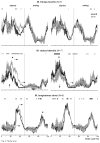Adaptations in muscle activity to induced, short-term hindlimb lameness in trotting dogs
- PMID: 24236207
- PMCID: PMC3827467
- DOI: 10.1371/journal.pone.0080987
Adaptations in muscle activity to induced, short-term hindlimb lameness in trotting dogs
Abstract
Muscle tissue has a great intrinsic adaptability to changing functional demands. Triggering more gradual responses such as tissue growth, the immediate responses to altered loading conditions involve changes in the activity. Because the reduction in a limb's function is associated with marked deviations in the gait pattern, understanding the muscular responses in laming animals will provide further insight into their compensatory mechanisms as well as help to improve treatment options to prevent musculoskeletal sequelae in chronic patients. Therefore, this study evaluated the changes in muscle activity in adaptation to a moderate, short-term, weight-bearing hindlimb lameness in two leg and one back muscle using surface electromyography (SEMG). In eight sound adult dogs that trotted on an instrumented treadmill, bilateral, bipolar recordings of the m. triceps brachii, the m. vastus lateralis and the m. longissimus dorsi were obtained before and after lameness was induced. Consistent with the unchanged vertical forces as well as temporal parameters, neither the timing nor the level of activity changed significantly in the m. triceps brachii. In the ipsilateral m. vastus lateralis, peak activity and integrated SEMG area were decreased, while they were significantly increased in the contralateral hindlimb. In both sides, the duration of the muscle activity was significantly longer due to a delayed offset. These observations are in accordance with previously described kinetic and kinematic changes as well as changes in muscle mass. Adaptations in the activity of the m. longissimus dorsi concerned primarily the unilateral activity and are discussed regarding known alterations in trunk and limb motions.
Conflict of interest statement
Figures


Similar articles
-
Limb and back muscle activity adaptations to tripedal locomotion in dogs.J Exp Zool A Ecol Genet Physiol. 2015 Oct;323(8):506-15. doi: 10.1002/jez.1936. Epub 2015 Jul 22. J Exp Zool A Ecol Genet Physiol. 2015. PMID: 26200094
-
Compensatory load redistribution of horses with induced weightbearing hindlimb lameness trotting on a treadmill.Equine Vet J. 2004 Dec;36(8):727-33. doi: 10.2746/0425164044848244. Equine Vet J. 2004. PMID: 15656505
-
Compensatory load redistribution in walking and trotting dogs with hind limb lameness.Vet J. 2013 Sep;197(3):746-52. doi: 10.1016/j.tvjl.2013.04.009. Epub 2013 May 15. Vet J. 2013. PMID: 23683534
-
Load redistribution in walking and trotting Beagles with induced forelimb lameness.Am J Vet Res. 2013 Jan;74(1):34-9. doi: 10.2460/ajvr.74.1.34. Am J Vet Res. 2013. PMID: 23270343
-
Neural adaptations to resistive exercise: mechanisms and recommendations for training practices.Sports Med. 2006;36(2):133-49. doi: 10.2165/00007256-200636020-00004. Sports Med. 2006. PMID: 16464122 Review.
Cited by
-
Surface Electromyography of the Longissimus and Gluteus Medius Muscles in Greyhounds Walking and Trotting on Ground Flat, Up, and Downhill.Animals (Basel). 2020 Jun 3;10(6):968. doi: 10.3390/ani10060968. Animals (Basel). 2020. PMID: 32503131 Free PMC article.
-
Adaptations in equine appendicular muscle activity and movement occur during induced fore- and hindlimb lameness: An electromyographic and kinematic evaluation.Front Vet Sci. 2022 Nov 8;9:989522. doi: 10.3389/fvets.2022.989522. eCollection 2022. Front Vet Sci. 2022. PMID: 36425119 Free PMC article.
-
Kinematic adaptions to induced short-term pelvic limb lameness in trotting dogs.BMC Vet Res. 2018 Jun 13;14(1):183. doi: 10.1186/s12917-018-1484-2. BMC Vet Res. 2018. PMID: 29895307 Free PMC article.
-
Functional assessment of the gluteus medius, cranial part of the biceps femoris, and vastus lateralis in Beagle dogs based on a novel gait phase classification.J Vet Med Sci. 2021 Jan 14;83(1):116-124. doi: 10.1292/jvms.20-0127. Epub 2020 Nov 23. J Vet Med Sci. 2021. PMID: 33229819 Free PMC article.
-
Surface electromyography in animal biomechanics: A systematic review.J Electromyogr Kinesiol. 2016 Jun;28:167-83. doi: 10.1016/j.jelekin.2015.12.005. Epub 2015 Dec 21. J Electromyogr Kinesiol. 2016. PMID: 26763600 Free PMC article.
References
-
- Schaeffer PJ, Lindtstedt SL (2013) How animals move: comparative lessons on animal locomotion. Compr. Physiol (Bethesda Md.) 3: 289-314. - PubMed
Publication types
MeSH terms
LinkOut - more resources
Full Text Sources
Other Literature Sources

